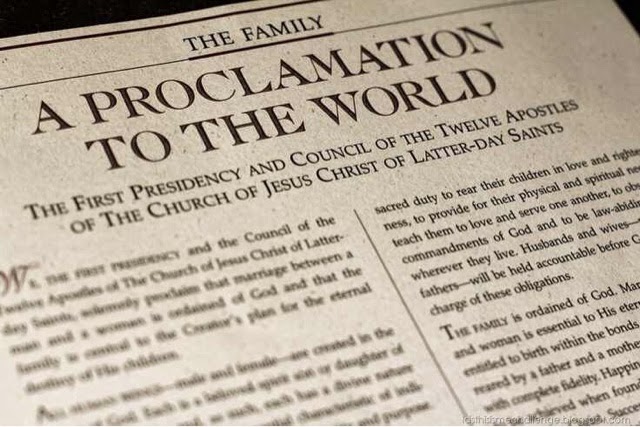Question
Dear Gramps,
Why is it that the Proclamation on the Family and the other one about Jesus Christ has not been added to our canon of scripture? Did it take years and years before the revelation on the priesthood by Pres. Kimball got added to the D&C?
Thanks,
Jeremy
Answer
Jeremy,
I’ve heard many people ask this question. And I believe it speaks to the nature of what canonical scripture is. Look at what we have.
1) A spiritual history of a covenant people. This includes much of the Old Testament, the Gospels, the Acts, the Book of Mormon, and Section 135 of the D&C.
2) A record of divine visions that are meant to be for the general population. (The Revelation of John, certain sections of the D&C)
3) Direct revelations concerning the will of the Lord. Or the direct actions as a result of a direct revelation from the Lord (Many sections of the D&C, the Official Declarations).
4) Statement of doctrine that has heretofore been undeclared or unclear. (Pauline Epistles).
(To save time and space, I’ll primarily discuss the Proclamation as an example of what I speak of. But similar things could be said of The Living Christ.)
Most likely, these documents you speak of might best fit into category #4. I think it is a stretch to say that any of these documents has information that was undeclared or unclear. Instead, I see it as a summary of what is already revealed. So, there is no bending around the idea that this is not official doctrine.
That marvelous document [the Proclamation] brings together the scriptural direction that we have received that has guided the lives of God’s children from the time of Adam and Eve and will continue to guide us until the final winding-up scene. —Elder David B. Haight (Be a Strong Link, General Conference, Oct 2000).
It seems very much like the type of information we would receive from General Conference. In fact, it was originally given at the Relief Society session of the Oct 1995 conference. The Proclamation was originally an address given by Pres. Gordon B. Hinckley at the Sep 1995 General Relief Society meeting. It’s purpose was to “warn and forewarn” of the world’s deviating standards.
We are told that the conference edition of Ensign should stand side-by-side with our scriptures for that six month period. And we ought to study it just as we do the scriptures. We’ve had these documents for much longer than six months. And they continue to stand as a Liahona for us to give heed in these troubled times. Indeed, as he introduced this document, he implored all to read it prayerfully.
The work of the David M. Kennedy Center of BYU uses it as a central document for standing up for family values. (New Family Voice pushes old values)
The Church used it as a basis for an amicus brief in a same-sex marriage case in Hawaii. (Baehr v. Miike)
When the world is trying to tell us that the traditional family doesn’t matter and that Christianity is false, it is encouraging to know that we can be led by inspired men who know what to focus on to help us stay close to the Lord.
My suspicion is that they will become canonized at some point. If not it doesn’t diminish the importance of the doctrines contained therein. We know that the principles espoused in it are official doctrines from the Lord as outlined in other scriptures. Those who wish to discount it also discount the scriptures that it cites as well as the repeated emphasis by multiple apostles since its introduction. Such individuals will not be swayed simply because it is packaged differently. So, I’m not sure how much it matters at this point.
Also, very much like the Bill of Rights does to the Constitution, it currently stands out as a separate document. As such, it has some additional emphasis in our Church culture.
If it does become canonized, there would be some level of effort required to integrate it into scripture (what with footnotes and such). And for the reasons I’ve stated, such an effort may not currently be a high priority.
Gramps







